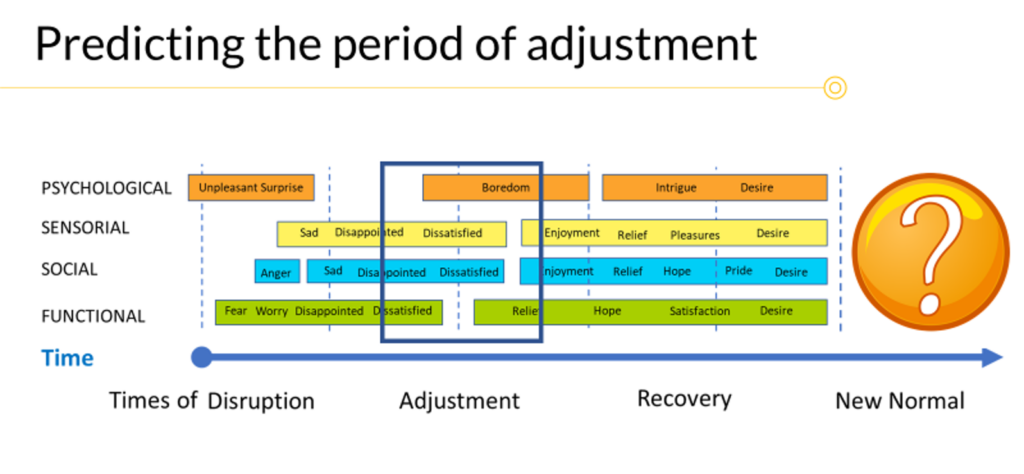In this time of great disruption, consumers may seem like a moving target. If you are charged with innovation or marketing for your company, you need information to know how to respond to not only the disruptions of the moment, but to prepare your brands for the future. For this reason, we are applying a behavioral framework to not only provide insights into how and why consumers are changing now, but also to provide accurate foresights into what will become the post-coronavirus new normal.
The Emotions Insight Wheel™ was developed in 2011 by InsightsNow Founder and CEO Dave Lundahl. It provides a framework to understand the motivators of behavioral change. A simplified version of this framework in shown here. This framework separates motivators into four quadrants: functional, social, sensorial and psychological.
Motivators can be product cues that signal benefits (or rewards) that products will provide in the context of moments.
- Functional motivators are cues that signal a product will be safe, healthy or convenient.
- Social motivators signal a product will provide social connectedness or reinforce self-social identities.
- Sensory motivators signal products will be enjoyed and fit within sensory expectations (e.g. ethnic food).
- Psychological motivators signal a product will yield comfort, the promise of surprise or an opportunity for mood change (e.g. relaxing).

Motivators can also be environmental cues that trigger routines for how we shop, prepare to use products and use them. In times of disruption, old motivators become obsolete and new motivators are formed.
This framework of motivators can be applied to not only form insights about how to design products to signal benefits and rewards as promised through market communications, they also can be applied to forecast behavioral change.
We broke up the time of behavioral change into four periods of adjustment. We then applied the Emotions Insight Wheel™ to create timelines of our forecasted functional, social, sensorial and psychological motivators.

Guided by the framework, we were able to form some initial forecasts for how we believe new motivators, cues and their respective emotions might shape future consumer behavior. Our current tracking research into the novel coronavirus change is applying this framework to design qualitative and quantitative research. Further, as we learn more through this research, we are using this framework to update, validate and shape our future forecasts into how this “Time of Disruption” will lead to new behaviors during the “Period of Adjustment” and beyond.
Motivators and Emotions
Motivators drive future behaviors by eliciting emotions during product or shopping experiences. This can be disappointment or relief against hopes or fears, (dis)satisfaction against expectations, sense of pride or shame, or feelings of boredom or surprise against expectations. They also elicit feelings of liking or product love. The greater these emotions, the stronger the memory of past experiences and desire to take new actions to avoid, mitigate or repeat. As people consider their options for how to change their behaviors, anticipation emotions such as hope, fear, intrigue, desire or disgust come into play to motivate how they will act.
Our recommendations for companies:
Address New Motivators During “Time of Adjustment”
- Prioritize communications and marketing innovations which address new functional and social motivators.
- Use an innovation idea starter, such as: how can you better deliver a shared social experience when the people are only sharing the experience virtually?
Prepare for “Time of Recovery”
- Monitor change in motivations to align brands and products for “Time of Recovery” growth.
- Re-contextualize your product messaging to align with the new situations people are currently experiencing.
- Prioritize short-term innovations and communications which address emerging changes in functional (e.g. dissatisfactions), psychological (e.g. boredoms), social (e.g. new prides) and sensorial (e.g. new enjoyments) motivators.
Prepare for “New Normal”
- Monitor change in motivators to predict long-term change in motivators among category users.
- Focus long-term innovation plans on how “Time of Recovery” leads to new desires driven by change in functional, social, psychological and sensorial motivations.
As we move through these four periods of change, you can gain access to our weekly updates into how shopping and consumer behavior is changing (click here). We will also notify you of relevant new behavioral research reports when they become available into novel coronavirus behavioral impact on topics such as consumer trust, clean living and trends in changing motivators impacting food, beverage, supplement, pet food and non-food products.
Emotions Insights Wheel™ is one of several frameworks in InsightsNow’s BehaviorLens Approach®.
For a business strategy to succeed, it must shake up the status quo and disrupt consumer behavior habits.





